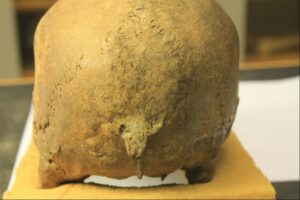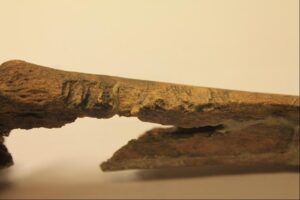
UNIVERSITY OF SOUTH FLORIDA—TAMPA, Fla. (Aug. 28, 2024) – Rates of violence in Viking Age Norway and Denmark were long believed to be comparable. A team of researchers including University of South Florida sociologist David Jacobson challenges that assumption.
Their findings* show that interpersonal violence – violence not meted out as punishment by authorities — was much more common in Norway. This is evident in the much greater rates of trauma on skeletons and the extent of weaponry in Norway. The study, published in the Journal of Anthropological Archaeology, sheds new light on how Viking Age societies in Norway and Denmark differed in their experiences with violence and the role social structures played in shaping those patterns.
Jacobson is part of an interdisciplinary team that combined archaeology and sociology along with the study of skeletons and of runestones – raised stones bearing inscriptions – to reveal key differences in how violence, social hierarchies and authority influenced these dynamics in the two regions. The other scholars on the team are from Norway and Germany.
“The interdiscipilinary approach taken in this study shows us how social and political patterns can be revealed, even when there are a paucity of written sources,” Jacobson said.
Norway: A More Violent Society?
Researchers analyzed skeletal remains from Viking Age Norway and Denmark and found that 33% of the Norwegian skeletons showed healed injuries, indicating that violent encounters weren’t uncommon. By comparison, 37% of the skeletons showed signs of lethal trauma, highlighting the frequent and often fatal use of weapons in Norway.
A notable feature in Norway was the presence of weapons, particularly swords, alongside skeletons in graves. The study identified more than 3,000 swords from the Late Iron Age and Viking periods in Norway, with just a few dozen in Denmark. These findings suggest weapons played a significant role in Norwegian Viking identity and social status – further emphasizing the culture’s connection to violence.
Denmark: Steeper Social Hierarchies and Controlled Violence
In Denmark, the findings show a different pattern. Danish society was more centralized, with clearer social hierarchies and stronger central authority. Violence was more organized and controlled, often linked to official executions rather than acts of personal violence.
For example, skeletal remains in Denmark showed fewer signs of weapon-related injuries but included evidence of executions such as decapitations. Skeletal evidence suggests about 6% of Viking Danes died violently, almost all from executions.
Denmark’s more structured society also had a smaller percentage of graves containing weapons than Norway’s. Instead, social order was maintained through political control, reflected in the construction of large earthworks and fortifications. These monumental structures, particularly during the reign of King Harald Bluetooth in the 10th century, demonstrated Denmark’s greater capacity for coordinated labor and more organized social hierarchies.
Why the Differences?
The study suggests that Denmark’s more rigid social structure meant that violence was less frequent but more systematically enforced through official channels, such as executions. Meanwhile, Norway’s more decentralized society experienced more peer-to-peer violence, as indicated by the higher levels of trauma found in skeletons.
The findings also support the broader theory that stronger authority and steeper social hierarchies can reduce the overall levels of violence in a society by centralizing the use of force under official control.
“The findings of these patterns suggest that we are talking of distinct societies in the regions of Norway and Denmark,” Jacobson said. “This is quite striking, as the assumption has been that socially Viking Scandanavia was largely a singular space.”
Broader Implications
The research contributes to a growing body of work that explores how social structures influenced violence in historical societies. Similar patterns have been observed in other parts of the world, such as the Andes region of South America and in areas of North America, where less centralized societies also experienced higher levels of violence.
Jacobson said he hopes the study “is a step towards a new explanatory model, especially when written sources from the period are partial or even nonexistent.”
Note: Scholars from the University of Oslo, Deutscher Verband für Archäologie in Germany and the Norwegian University of Science and Technology also were part of the research team.
###
About the University of South Florida
The University of South Florida, a high-impact research university dedicated to student success and committed to community engagement, generates an annual economic impact of more than $6 billion. With campuses in Tampa, St. Petersburg and Sarasota-Manatee, USF serves approximately 50,000 students who represent nearly 150 different countries. U.S. News & World Report has ranked USF as one of the nation’s top 50 public universities for five consecutive years, and this year USF earned its highest ranking ever among all universities public or private. In 2023, USF became the first public university in Florida in nearly 40 years to be invited to join the Association of American Universities, a prestigious group of the leading universities in the United States and Canada. Through hundreds of millions of dollars in research activity each year and as one of the top universities in the world for securing new patents, USF is a leader in solving global problems and improving lives. USF is a member of the American Athletic Conference. Learn more at www.usf.edu.
___________________________

From the Viking skeletal study: A skull displaying blunt force trauma with radiating lines. Lisa Mariann Strand
___________________________

From the Viking skeletal study: Antemortem damage is observable with remodeling of the occipital bone. Lisa Mariann Strand
___________________________

From the Viking skeletal study: Weapon related lesions identified on sacrum side and tibia. Lisa Mariann Strand
___________________________
Article Source: UNIVERSITY OF SOUTH FLORIDA news release.
*Violence as a lens to Viking societies: A comparison of Norway and Denmark, Journal of Anthropological Archaeology, 26-Jun-2024.
___________________________
Advertisement

EXPLORE THE ANCIENT ETRUSCANS IN PERSON!
Experience a unique, up-close-and-personal hike among ancient hilltop towns in central Italy. You will walk the sensational countryside of the regions of Umbria and Tuscany, soaking in important sites attesting to the advanced Etruscan civilization, forerunners of the ancient Romans; imposing architectural and cultural remains of Medieval Italy; local food and drink; and perhaps best of all — spectacular scenic views! Join us in this collaborative event for the trip of a lifetime!




